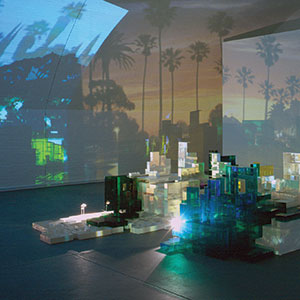What separates the American Dream from the one in California? The color of the sunset. Won Ju Lim’s California Dreamin’ at the San Jose Museum of Art is alive with it. She projects photographs of an ordinary Los Angeles street scene onto and across the gallery walls. Lim collected that raw footage herself, editing it at the same time that she worked on the sculptural elements filling up the rest of the room.
The images feature palm trees standing in formation against a blue sky washed in reds, oranges and yellows. Buildings line the horizon and merge together. Shadows swallow them up. But as your eyes get accustomed to the darkness, they also focus on the sculpture, a model city.
Simulated highrises, apartment complexes and office parks are pieced together. They’re rendered anonymous by square and rectangular shapes made of white foam core and stacks of translucent plexiglas in green, yellow and blue. This city in miniature, along with the shadow of your own body, gets cast inside the skyline projected onto the walls. Lim creates a metropolis that is both ephemeral and concrete. The sculpture evokes a place you’ve visited before but now resides in your mind as a fading memory, broken down in time, a hazy dream. The details are indistinct. You can only remember the sun as it was setting and how you felt when the night sky replaced those incandescent colors with cold and distant stars.
From her home in Los Angeles, Lim discusses the project over the phone. The artist explains that California Dreamin’, first exhibited in 2002, was just one of several large installations in a series titled “Futuristic Ruins.”
“These sculpture installations have to do with this idea of a place that is fictional and real at the same time,” she says. Lim’s practice is deeply rooted in architecture. Having studied it as an undergraduate, she went on to get an MFA in studio art. Now she invents blueprints for spectral structuresshimmering houses made of light, her intellect and jewel-colored plexiglas.
Lim was born in Gwangju, South Korea, but her family emigrated to Los Angeles when she was 8 years old. She recalls one essential difference between Korean and American homes: “In a Korean house, a lot of rooms are not designated for specific functions; they’re more fluid and porous.”
A breakfast room in the morning will later become a bedroom when the folding table is put away. But growing up in two dissimilar cultures isn’t how she accounts for her ability to create liminal spaces like the ones we experience in California Dreamin’.
“When it comes to [my] ethnic identity, I grew up in Los Angeles. Everybody’s in between here,” she says. “Artists in general are always between, on the periphery of looking at culture from outside, and at the same time being a part of culture.”
In 2015, she exhibited Raycraft Is Dead at the Yerba Buena Center for the Arts in San Francisco. One of the sculptures was a model of her house in Southern California. Like many other Angelenos, Lim’s become adept at mythologizing her adopted hometown.
“What I love about living in L.A. is that this border between inside and outside is always blurry,” she says. When she started mapping out California Dreamin’, she thought about scale. “I thought about a sculpture that’s bigger than the human body. I thought about details so that the viewers could project themselves into the model. And also I thought about materials I could use that would absorb and reflect and refract the light.”
“California Dreamin'”the name of the exhibit as well as the centerpiece installationalso includes three lightboxes in a numbered series called Memory Palace, Terrace 49. They’re smaller narratives that expand on contact, like the various worlds Joseph Cornell contained in his boxes.
A work titled #6 could be a neighborhood in Laurel Canyon, where houses and trees mingle on sloping hillsides. A backlight sets the insides of window frames on fire and distorts limbs and leaves so that all sense of proportion is lost. This is Lim’s vision of a California in reverse, a sunless one where dreams flare brightly then burn out.
Won Ju Lim: California Dreamin’
Thru Sep 30, $10
San Jose Museum of Art
sjmusart.org



